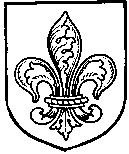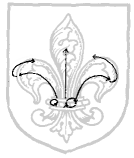
Flourdelice for 3

Fleur-de-lys
from AC Fox-Davies,
Complete Guide
to Heraldry

Flowerdelice over Fleur-de-lys
|
|
|
|
Singles and doubles |
Are the singles step and close as in Arbeau or the step and pause, like a passo, in the bassa dances? The dances work with either. The step lift style single suggested for earlier dances and the forerunner to an almain step would also work. Or they could be something more exotic, what about a hop and step or step and hop? Which is chosen will have an effect on how the trett is interpreted. At first I assumed that a single was the step close variety. I am beginning to lean towards the step pause or step lift singles now that I have had it explained that the step close single is a much latter development. |
|
|
|
|
Trett and retrett |
In Northumberland and Temperans a trett is described as three singles with a stop. Working on Esperans showed that a trett takes three bars. So a trett is could be
There is not enough music for the first. If the stop at the end is ignored then there is nothing different between a trett and three singles. If it is 3 passi with a close you have a slow double, i.e. a double in three bars. This would work. The last, a trett is to 3 singles what a double is to 2, gives a trett of step, step, step, step, step, close. This is the one I prefer. However we need to do some more experimenting with getting the flow of the dances. Currently they do not flow well. Unfortunately the author of the papers is not consistent with the use of “retrett”. He sometimes uses retrett as a trett done backwards, sometimes a single done backwards and sometimes it is a direction. In these documents I use retrett to mean a trett going backwards. |
|
|
|
|
Rak, raks, rakkes, rake |
Appears to be a sideways movement of indeterminate length (see #16 Aras and #26 Northumberland). Perhaps the Negri represa where the feet "zigzag"? While #19 (Roye) suggests a forward movement. One dance (#21 Hawthorne) calls for 3 raks with a stop, does this imply they are open steps? Oxford English Dictionary - has one description from 1530 - a horse's pace where both feet move on the same side. This is like the single step we do in Del's interpretation of the bassadanse Rositiboli. When doing singles the foot and shoulder on the same side move together. It could be a set, as in Inns of Court and ECD. It can be moving forward if you turn 45 degrees before the first step and 90 degrees thereafter. Rak, rakis, raks and rakkes do not appear in the Shorter Oxford English Dictionary. Rake also refers to a garden implement, a path or way and angle to the perpendicular (eg vein of oar, mast). The way a hawk flies after game. To run with nose to ground like a hound on scent. Currently We are treating this as a sort of continenza. You take a step to the side and rake the floor when you bring the other foot up to the first. |
|
|
|
|
Flourdelice |
The pattern of the flourdelice seems to represent the hereldic fleur-de-lys, with 3 people dancing it starting side by side. The only full description of it comes from Temperans where it takes 8 bars. |
|
|
|
|
|
|
|
|
|
|
|
|
The first double forms the bar as first casts out and the other two change places. In the 3 singles and jump (passo, passo, passo, cadence) the middle person goes straight forward forming the inner part while the two outside people go forward for the first passi and turn out and half way round on the second and third passi. The cadence is on the spot and is not part of the turn. Then the outside people cast out again on the last double to make the outside parts of the fleur-de-lys. |
|
|
|
|
A flourdelice from Temperans |
|
Person 1 casts left for a double while the other two change places |
|
|
|
All forward 3 singles (SR, SL, SR) with first
and second (ie the outside couple) turning outward and ending
facing the way they came. All leap in one bar (LL). |
|
|
|
Then the outside men cast out with a double so all end facing the same way side by side. DR |
|
|
|
|
|
If the fleur-de-lys is for two, depending on how they are placed at the start, they can cast or change places to make the bar and then do the outside parts of the three person version. If there are three in a small triangle the first double could be used to get into line by making the bit below the bar. Then do the rest the same. If there are three doing it one after the other maybe they do the individual parts. |
|
|
|